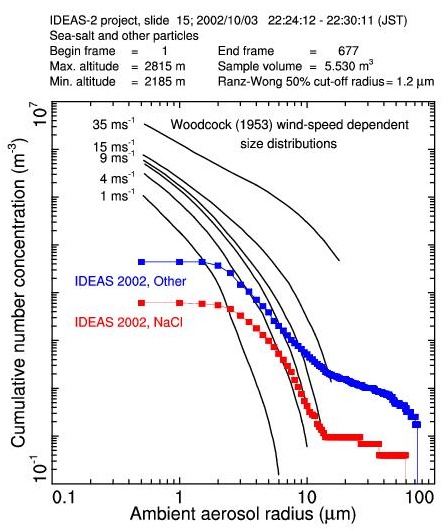Two DRI cloud scopes were tested in October. Several software-related issues caused problems with the cloud scopes during the first half of the project, but they were resolved by the third flight. A Nezorov total water instrument was purchased by the RAF and flown in October. The instrument arrived with a faulty control box that required repairs by the manufacturer, and the instrument was only fully operational on the last flight, which was an excellent flight with the cloud scopes also fully operational. Good comparisons between the cloud scopes and other instruments were made in a variety of cloud conditions.
Tested a system for simultaneously measuring Cloud Condensation Nuclei (CCN) while collecting samples for examination by Transmission Electron Microscopy. Flights through the Denver urban plume and a prescribed burn provided excellent data for these tests.
Jensen (RAF project scientist) has developed an automated system for counting and sizing microscope slides in both humidified and non-humidified conditions. The slides collect aerosol by impaction onto glass slides that are exposed at the end of a long rod. While the collection efficiency for particles less than 3 to 5 micrometers is poor, for large particles this system provides a much better sample volume than other methods. The automated sampling system allows tens of thousands of particles to be counted, so good statistics on the larger particles are available. The first size distributions using this system were measured during IDEAS and are presented in figure 1.

During the ACE-Asia program, an unusually large discrepancy was found in the local airflow that DU measured at the inlet of the Low Turbulence Inlet (LTI). DU wished to use a flow-angle system to confirm their measurements for different values of attack and sideslip. These were completed during the October IDEAS. Preliminary data analyses suggest that the discrepancy is due to static pressure perturbations at the location of the LTI.
Apel and Hills have developed a fast gas chromatograph for measuring oxygenated hydrocarbons down to the ppt level. Testing in a wide range of ambient conditions was needed. This was completed and the system performed well at the end of the October test flights.
The high-volume particle sampler (HVPS by Spec., Inc.) provides a much greater sampling volume for sampling large precipitation particles than older technology, such as the 2DP instrument from PMS. (This is especially useful for comparison with radar data that are particularly sensitive to the concentration of the largest particles.) However it has a different format and maintenance procedures. It took several attempts to integrate this instrument into the RAF data systems, but by the end of October, we were collecting data from the instrument that are now being analyzed to compare the performance of this instrument against the other cloud particle instrumentation.
Testing of the airborne version of this instrument continued during October, with a number of changes made to the system. We now believe that the system is viable and that we have the capacity for airborne precision oxygen measurements.
RAF has been developing a satellite-based system for real-time web display of airborne data. This system was tested during October. It allows anyone with a browser to view real-time data collection from the C-130Q. This type of system (with later improvements) will be especially useful for future field campaigns and for the educational use of the aircraft. This system also provides for data to be sent to the C-130Q in real time, such as, data from the CHILL radar which was operated concurrently for some of the October flights. This software did function for the latter part of October, but is in need of further development to display more of the data in a useful manner.
Professor Cotton's cloud dynamics class at Colorado State University (CSU) participated in the IDEAS flights in October. One student, Emily Wheeler, meteorology major from the University of Oklahoma, traveled to the RAF to participate. We followed a similar format for this class as we did in April, but also included coordinating our flights with the CHILL radar facility, so that concurrent radar and aircraft measurements could be made. Several students participated and were able to collect data for case studies of clouds in the area. Professor Cotton has agreed to share the results of this experiment with us, so we hope to learn more about how useful this experience was for the class. Because the data from both the C-130Q and the CHILL radar are available in real time on the web, there is the opportunity for students to participate in real-time experiments even if they are not able to travel to Colorado. Presently, we are exploring ways, such as funding travel costs for students, to make this experience available to more students from outside the regions. The Director of NCAR has expressed an interest in helping us in this regard. RAF staff have also received valuable feedback from the students concerning the ease of access to data products and software.